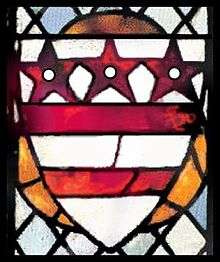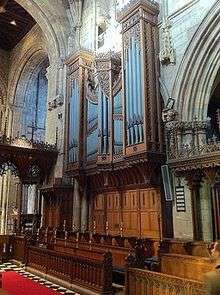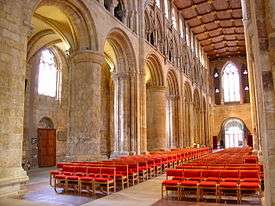Selby Abbey
Selby Abbey is an Anglican parish church in the town of Selby, North Yorkshire, England. It is Grade I listed.[1]
| Selby Abbey | |
|---|---|
 The West Front | |

| |
| OS grid reference | SE615323 |
| Country | United Kingdom |
| Denomination | Church of England |
| Churchmanship | Broad Church |
| Website | www.selbyabbey.org.uk |
| History | |
| Dedication | St Mary the Virgin and St Germain |
| Architecture | |
| Heritage designation | Grade I[1] |
| Administration | |
| Parish | Selby |
| Deanery | Selby |
| Archdeaconry | York |
| Diocese | York |
| Province | York |
| Clergy | |
| Priest(s) | The Revd Canon John Weetman |
| Assistant priest(s) | The Revd Dr Jacob Belder (Curate)
The Revd Dr Julie Watson The Revd Neil Woodhall |
| Honorary priest(s) | The Revd Canon Roy Matthews |
| Laity | |
| Organist/Director of music | Dr Roger Tebbet |
Monastic history
It is one of the relatively few surviving abbey churches of the medieval period, and, although not a cathedral, is one of the biggest. It was founded by Benedict of Auxerre[2] in 1069 and subsequently built by the de Lacy family.
On 31 May 1256, the Abbey was bestowed with the grant of a Mitre by Pope Alexander IV and from this date was a "Mitred Abbey". This privilege fell in abeyance a number of times, but on 11 April 1308, Archbishop William Greenfield confirmed the grant, and Selby remained a "Mitred Abbey" until the Dissolution of the Monasteries.
Archbishop Walter Giffard visited the monastery in 1275 by commission, and several monks and the Abbot were charged with a list of faults including loose living, (many complaints referred to misconduct with married women). In 1279 Archbishop William de Wickwane made a visitation, and found fault with the Abbot as he did not observe the rule of St Benedict, was not singing mass, preaching or teaching, and seldom attending chapter. Things had not improved much in 1306 when Archbishop William Greenfield visited and similar visitations in later years resulted in similar findings.
The community rebuilt the choir in the early fourteenth century, but in 1340, a fire destroyed the Chapter House, Dormitory, Treasury and part of the church. The damage was repaired and the decorated windows in the south aisle of the Nave were installed.
In 1380-1 there was the abbot and twenty-five monks. In 1393 Pope Boniface IX granted an indulgence to pilgrims who contributed to the conservation of the chapel of the Holy Cross in the Abbey.
The fifteenth century saw more alterations to the Abbey. The perpendicular windows in the North Transept and at the west end of the nave were added and the Sedilia in the Sanctuary was added. One of the final additions was the Lathom Chapel, dedicated to St Catherine, east of the North Transept, in 1465.
In the Valor Ecclesiasticus of 1535 the Abbey was valued at £719 2s. 6¼d (equivalent to £442,216 in 2019).[3] The abbey surrendered on 6 December 1539. The community comprised the Abbot, and 23 monks The abbot was pensioned off on £100 a year (equivalent to £67,623 in 2019) [3] the prior got £8 and the others between £6 6s. 8d. and £5 each.
Abbots of Selby
- Benedict 1069–1097
- Hugh de Lacy 1097–1123
- Herbert, 1123–1127
- Durand, 1127–1137
- Interregnum 1137–1139
- Walter 1139–1143
- Helias Paynel, 1143–1153
- German, 1153–1160
- Gilbert de Vere, 1160–1184
- Interregnum 1184–1189
- Roger of London, 1189–1195
- Richard I (prior), 1195–1214
- Alexander, 1214–1221
- Richard, 1221–1223
- Richard (sub-prior of Selby), 1223
- Hugh de Drayton, 1245–1254
- Thomas de Whalley, 1254–1263
- David de Cawod, 1263–1269
- Thomas de Whalley, 1254–1263
- William de Aslakeby (prior) 1280,-1293
- John de Wystow I (sub-prior), 1294–1300
- William de Aslaghby (sacrist), 1300–1313
- Simon de Scardeburg (prior), 1313–1321
- John de Wystow II, 1322–1335
- John de Heslyngton (a monk), 1335–1342
- Geoffrey de Gaddesby, 1342–1368
- John de Shirburn, 1369–1408
- William Pigot, 1408–1429
- John Cave, 1429–1436
- John Ousthorp, 1436–1466
- John Sharrow, 1466–1486
- Lawrence Selby, 1487–1504
- Robert Depyng (monk of Crowland Abbey) 1504–1518
- Thomas Rawlinson, 1518–1522
- John Barwic, 1522–1526
- Robert Selby, 1526–1540
Post monastic history
For a time after the dissolution, the church was unused but in 1618 it became the Parish Church of Selby. During the English Civil War and the Commonwealth period the building suffered with the north transept window being destroyed, and the statues on the brackets in the Choir were demolished.

Like York Minster, the church rests on a base of sand and has suffered from subsidence. Many sections collapsed entirely during the seventeenth century, including the central tower in 1690 which destroyed the south transept. The Tower was rebuilt, but not the transept. In the eighteenth century the Choir was filled with galleries, and used for services, the Nave only used for secular purposes.
The church was restored by Sir George Gilbert Scott in 1871–1873 who restored much of the nave for use, and again in 1889–1890 by his son John Oldrid Scott, who restored the choir. The tower was restored in the first few years of the twentieth century.
The reredos was designed by Robert Lorimer and added in 1901.[4]
The fire of 1906

The organ builders from John Compton had been working until 11.00 pm on Friday 19 October, and shortly after midnight on Saturday the organist Frederick William Sykes spotted flames coming from the organ chamber.[5] The organ builders had been installing a new kinetic gas engine to provide power to the new organ. Initial reports that the new organ equipment was to blame for the fire were later proved inaccurate.[6]
The fire destroyed the roof of the choir and the belfry and peal of eight bells was also destroyed. All of the interior fittings were also destroyed but thanks to the actions of the local fire brigade, the fourteenth-century stained glass in the East window was saved.
A secondary fire broke out in the nave roof on the Sunday, but this was quickly extinguished.[7]
The abbey was rebuilt under the supervision of John Oldrid Scott at a cost of around £50,000 (equivalent to £5,250,000 in 2019) [3] and reopened in 1909. The restoration of the south transept was completed in 1912, funded by William Liversedge.
Later twentieth century
In 1935 the architect Charles Marriott Oldrid Scott, son of John Oldrid Scott, raised the height of the towers at the front.
In 1952 the Abbey was given Grade I listed status.[1]
In 1969 Selby Abbey became the first parish church to hold the annual service for the distribution of the Royal Maundy.
Restorations of 2002
The Abbey is currently undergoing an extensive restoration, costing several million pounds. Stage 6, the restoration of the Scriptorium was completed at a cost of £795,000. The £400,000 cost of restoring the South Choir Aisle and the 'Washington Window' was met in full by British American Tobacco.[8] World Monuments Fund committed more than $800,000 to exterior work, including roof repairs, beginning in 2002.
The Vicars of Selby
- Anthony Ashton 1540 – 1583
- Robert Dove 1583 – 1586
- Thomas Tomlinson 1586 – 1603
- John Bradley 1603 – 1610
- Thomas Greenwood 1610 – 1613
- John Moor 1613 – 1620
- Richard Smith BA 1620 – 1625
- John Whitaker BA 1625 – 1642
- Paul Hammerton 1642 – 1650
- Richard Calvert 1650 – 1658
- Thomas Birdsall 1658 – 1666
- Arthur Squire MA 1666 – 1698
- Shadrach Sherburn BA 1698 – 1701
- Henry Allan 1701
- Geoffrey Rishton 1701 – 1720
- Thomas Hardy 1720 – 1728
- William Charnley BA 1728 – 1748
- Marmaduke Teasdale BA 1748 – 1778
- William Porter MA 1778 – 1796
- William Caile 1796 – 1797
- Thomas Mounsey 1797 – 1819
- Jonathan Muncaster 1819 – 1834
- John Leidger Walton MA 1834 – 1850
- Francis Whaley Harper MA 1850 – 1889
- Archibald George Tweedie MA 1889 – 1904
- Maurice Parkin MA 1904 – 1910
- John Solloway DD 1910 – 1941
- Alfred Edgar Moore Glover MA 1941 – 1945
- Frank Read AKC 1945 – 1952
- John Aldwyn Pelham Kent MA 1952 – 1978
- Anthony Cecil Addison Smith MA 1978 – 1983
- Michael William Escritt DipTh 1983 – 1990
- Peter Lawrence Dodd MBE 1990 – 1993
- James Alexander Robertson 1993 – 1996
- Roy Ian John Matthews TD MA 1996 – 1997
- Keith Michael Jukes BA 1997 – 2007
- Keith David Richards 2007 – 2010
- Canon John Weetman 2011 –
Architecture
The tower is Norman, but the eastern end is in Decorated Gothic style, and the west front a mixture of Norman, Gothic and Victorian.
The interior bears some similarity to that of Durham Cathedral, on which the design was modelled. Richly-carved and moulded capitals are found throughout the church. A major feature is the east window, which contains original medieval glass and depicts the Tree of Jesse, a popular subject of that period. The chancel stonework is thought to have been designed by Henry Yevele.

A notable feature of the abbey is the fifteenth-century[9] Washington Window, featuring the heraldic arms of the ancestors of George Washington, the first president of the United States. The design, featuring three red stars above two red bands on a white shield, formed the model for the flag of the District of Columbia.
Organ

The first organ since the reformation was installed in 1825 by Renn and Boston, in a gallery on the east side of the choir screen wall. This organ was rebuilt several times by Booth of Wakefield, Forster and Andrews of Hull and Conacher of Huddersfield. In 1868 the organ was rebuilt and moved to a bay in the choir. The opening recital was given by William Thomas Best.
The organ was rebuilt in 1891 by James Jepson Binns of Bramley and moved again onto the north side of the choir. A rebuild took place by John Compton in 1906 but was soon afterwards destroyed by the fire.
A new organ was built by William Hill dating from 1909, and two new organ cases were provided to designs by John Oldrid Scott, either side of the choir. This organ has subsequently been restored by Hill, Norman and Beard in 1950. Opening recitals were given by Francis Jackson and Melville Cook. Following this rebuild, the noted Italian organist Fernando Germani made a series of LP recordings at the Abbey for HMV which brought the organ to international attention.
A further restoration took place by John T. Jackson in 1975.[10] As of 2014, the organ is out of service awaiting a restoration.
In 2002, Principal Pipe Organs provided a small chamber organ which is located in the chancel.
Organists
- Mr. Wilkinson 1825 – 1832
- Mr Whitelock 1832
- David Smorfitt early 1840s
- Mary Milnes 1854 – 1864
- Wharton Hooper 1864[11] – 1866
- William Riley 1866 – 1875
- W.H. Smithson 1875 – 1878
- Edward Johnson Bellerby 1878 – 1881 (afterwards organist of Holy Trinity Church, Margate)
- Frederick William Sykes 1881[12] – 1912[13] – 1919
- Henry Oswald Hodgson 1919 – 1921 (afterwards organist of Church of All Saints, Leighton Buzzard and then St. Mary's Church, Nottingham)
- Herbert Hill 1921[14] (formerly organist of Southend on Sea)[15] – 1922[16]
- Walter Hartley 1922 – 1962
- David Patrick Gedge 1962 – 1966 (afterwards organist at Brecon Cathedral)
- Mervyn John Byers 1966 – 1976 (previously at St Andrew's Cathedral, Sydney, Australia.)
- Peter Seymour 1976 – 1978
- Dr Anthony Langford 1978 – 1981[17]
- Mervyn John Byers 1980 – 1987
- Geoffrey Pearce 1987 – 1994 Previously Organist and Master of the Choristers at St Andrew's Cathedral, Aberdeen (Episcopal) from 1974
- Roger Tebbet 1994 –
Burials
- Thomas Thwaites and wife Alice de la Hay
- various of the Abbots
Bishop of Selby

The Bishop of Selby is a Suffragan Bishop to the Archbishop of York and oversees the Archdeaconry of York, which includes the Deanery of Selby.

Selby Abbey is one of twenty members of the Greater Churches Group.
See also
References
- Historic England. "Church of St Mary and St Germain (Selby Abbey) (1132591)". National Heritage List for England. Retrieved 29 August 2016.
- "Selby and Tadcaster History". northeastengland.talktalk.net. Retrieved 16 May 2009.
- UK Retail Price Index inflation figures are based on data from Clark, Gregory (2017). "The Annual RPI and Average Earnings for Britain, 1209 to Present (New Series)". MeasuringWorth. Retrieved 2 February 2020.
- Dictionary of Scottish Architects: Robert Lorimer
- Western Times, Monday 22 October 1906. p.4. Selby Abbey Entirely Destroyed by Fire on Saturday
- Sheffield Evening Telegraph. Friday 14 December 1906. p.5. The Selby Abbey Fire
- Gloucester Citizen, Monday 22 October 1906. p.5. The Fire at Selby Abbey
- "Restoring Selby Abbey: The Challenge We Face". Selby Abbey. Retrieved 23 May 2009.
- "Washington Window". Retrieved 25 April 2013.
- National Pipe Organ Register
- Hampshire Telegraph – Saturday 20 August 1864
- Yorkshire Gazette – Saturday 3 December 1881
- Thornsby, Frederick W., ed. (1912) Dictionary of Organs and Organists. Bournemouth : Logan.
- Thornsby, Frederick W., ed. (1921) Dictionary of Organs and Organists; 2nd ed. London: G. A. Mate
- Hull Daily Mail – Friday 7 January 1921
- Hull Daily Mail 7 March 1922
- International Who's Who in Music and Musicians' Directory. International Bibliographical Centre (Cambridge), 1988
External links
| Wikimedia Commons has media related to Selby Abbey. |